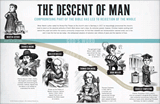
Billions of People in Thousands of Years?
The math supporting the earth’s population reaching billions of people in a ~6,000 year old world starting with just two humans
Creationists are often asked, “How is it possible for the earth’s population to reach billions of people if the world is only about 6,000 years old and if there were just two humans in the beginning?” Here is what a little bit of simple arithmetic shows us.
Simple, conservative arithmetic reveals clear mathematical logic for a young age of the earth.
One Plus One Equals Billions
Let us start in the beginning with one male and one female. Now let us assume that they marry and have children and that their children marry and have children and so on. And let us assume that the population doubles every 150 years. Therefore, after 150 years there will be four people, after another 150 years there will be eight people, after another 150 years there will be sixteen people, and so on. It should be noted that this growth rate is actually very conservative. In reality, even with disease, famines, and natural disasters, the world population currently doubles every 40 years or so.1
After 32 doublings, which is only 4,800 years, the world population would have reached almost 8.6 billion. That’s 2 billion more than the current population of 6.5 billion people, which was recorded by the U.S. Census Bureau on March 1, 2006.2 This simple calculation shows that starting with Adam and Eve and assuming the conservative growth rate previously mentioned, the current population can be reached well within 6,000 years.
Impact of the Flood
We know from the Bible, however, that around 2500 BC (4,500 years ago) the worldwide Flood reduced the world population to eight people.3 But if we assume that the population doubles every 150 years, we see, again, that starting with only Noah and his family in 2500 BC, 4,500 years is more than enough time for the present population to reach 6.5 billion.
From two people, created about 6,000 years ago, and then the eight people, preserved on the Ark about 4,500 years ago, the world’s population could easily have grown to the extent we now see it—over 6.5 billion.
Evolutionists are always telling us that humans have been around for hundreds of thousands of years. If we did assume that humans have been around for 50,000 years and if we were to use the calculations above, there would have been 332 doublings, and the world’s population would be a staggering figure—a one followed by 100 zeros; that is
10,000,000,000,000,000,000,000,000,000,000,This figure is truly unimaginable, for it is billions of times greater than the number of atoms that are in the entire universe! Such a calculation makes nonsense of the claim that humans have been on earth for tens of thousands of years.
000,000,000,000,000,000,000,000,000,000,
000,000,000,000,000,000,000,000,000,000,
000,000,000.
Simple, conservative arithmetic reveals clear mathematical logic for a young age of the earth. From two people, created around 6,000 years ago, and then the eight people, preserved on the Ark about 4,500 years ago, the world’s population could have grown to the extent we now see it—over 6.5 billion.
With such a population clearly possible (and probable) in just a few thousand years, we could actually ask the question, “If humans were around millions of years ago, why is the population so small?” This is a question that evolution supporters must answer.
Answers Magazine
October – December 2006
This issue covers topics such as family trees, secular holidays, global warming, and more.
Browse Issue SubscribeFootnotes
- www.census.gov/ipc/www/img/worldpop.gif
- Editor’s note: As of 2021, the current figure is 7.67 billion people.
- White, A. J. Monty, How Old Is the Earth? Evangelical Press, p. 22, 1985.
Recommended Resources

Answers in Genesis is an apologetics ministry, dedicated to helping Christians defend their faith and proclaim the good news of Jesus Christ.
- Customer Service 800.778.3390
- © 2024 Answers in Genesis






